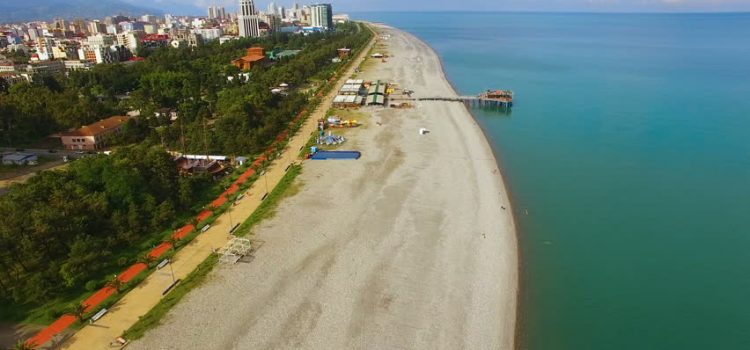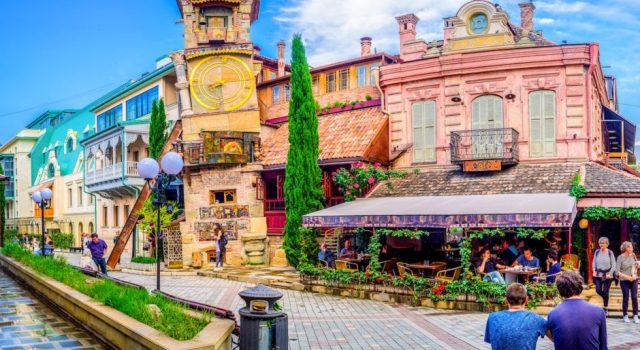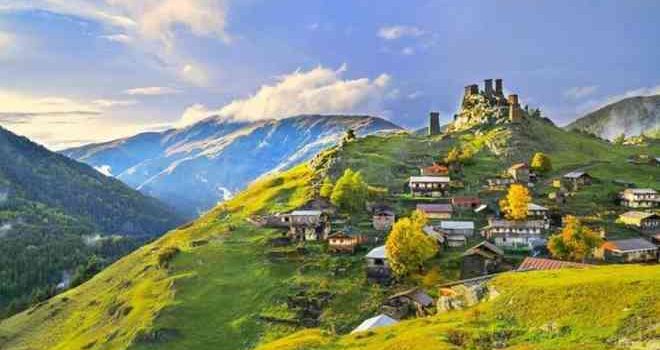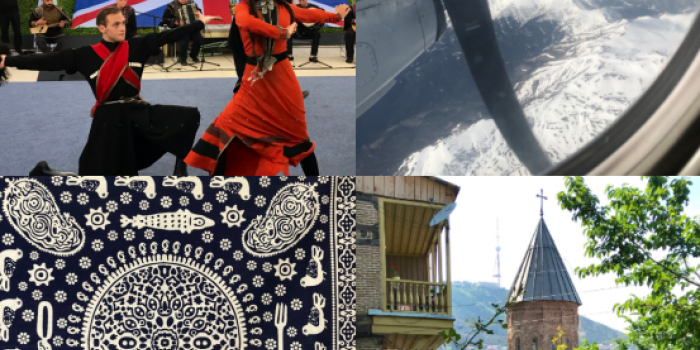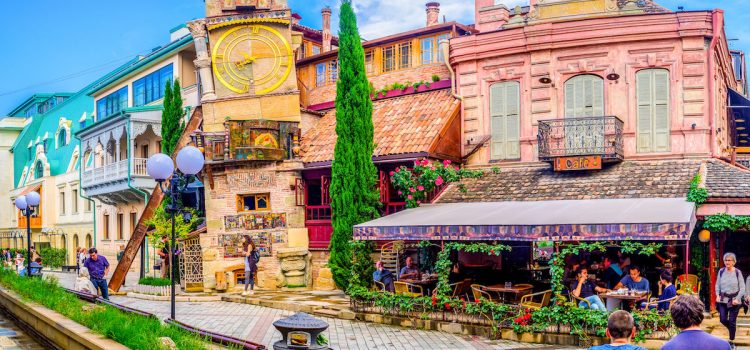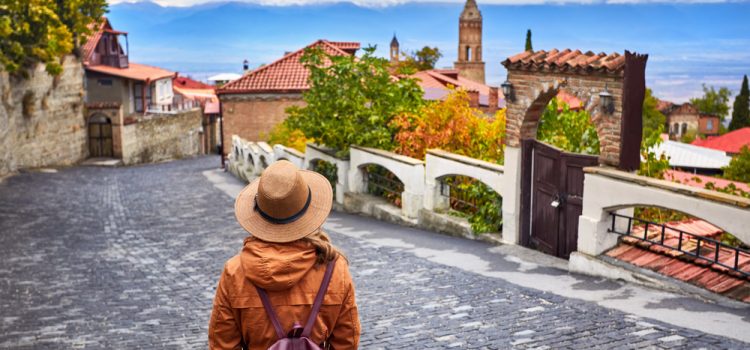Georgia on their minds: why tourists are flocking to the Black Sea
The city of Batumi on Georgia’s Black Sea coast is bracing for a tourism boom after winning the 2019 title of “Europe’s Leading Emerging Tourism Destination” at the prestigious World Travel Awards.
In recent years, the region has attracted significant investment. And the results are clearly visible.
The summer season has just begun but already tourist figures are breaking records. Dozens of new hotels have appeared along the coast and the number of international visitors in Batumi has almost doubled since the beginning of this year.
It’s also gaining a reputation as a centre of youth culture.
Joseph, a young street-artist, believes his city has much more to offer.
He’s confident that soon Batumi will be a focal point for creative youth and compete on an equal footing with the capital, Tbilisi.
“You can see how the city has changed on a cultural level – cinema, theatre, music, poetry, architecture, art etc,” he told Focus. “Batumi is in a constant state of development and we are able to create new trends in the cultural life of the city.”
In Georgia new cultural trends are closely intertwined with the country’s rich traditions and history.
It’s no surprise that Georgian polyphonic singing was recognised as Intangible Cultural Heritage by UNESCO.
Add to this the region’s beautiful and diverse landscapes and you get a fuller picture of Adjara and its tourism potential.
You can head straight from the beach to the mountains and picturesque valleys. It’s all possible in Adjara, thanks to its unique ecosystem.
Tornike Rijvadze, Chairman of the Government of Adjara, told Focus: “Ecotourism is actually one of the greatest opportunities we’ve got here. Our agencies work very hard to find new directions. We expect to have quite a successful season this year.”
The region is also famous for its wine. According to archaeologists, winemaking in Georgia can be traced back thousands of years.
Local winemaker Rostom Beridze, said there are almost 500 types of grape varieties in Georgia and about 50 of them grow in Adjara.
“Such diversity gives us an advantage in creating wines that are very different from what you can find elsewhere,” he said.
Beridze added: “It’s impossible to talk about wine and not be in a positive mood. We are very proud of our winemaking heritage.”
Source: www.Euronews.com
tbilisi, possibly the coolest city in the world
When it comes to Tbilisi it’s safe to say the secret’s out. The capital of Georgia has been charming worldwide travellers with its alternative arts scene, world-class clubs and unforgettable cuisine for a while now – and it’s undoubtedly becoming one of the trendiest cities in Europe.
It’s a city of two halves; the Old Town is cluttered with antique stores selling Soviet-era war medals while younger, trendier areas are known for their lively bars filled with locals toasting firewater with strangers. The city feels familiar yet alien all at once, and it’s hard not be overcome by the welcoming Georgian lifestyle.
Georgia’s art scene, fashion and nightlife are behind the influx of traffic. If you’ve been to Berlin then you’ll recognise Tbilisi. They have distinctive similarities but Tbilisi feels effortless. Maybe the city manifests what Berlin was… once upon a time?
Like Berlin, raving is central to younger Georgians’ identity with techno music being the soundtrack to those seeking social liberty and cultural freedom. The underground club Bassiani is a concrete Mecca for techno; the main dance floor is a disused swimming pool and at weekends it’s flooded with smokey, Chacha fuelled clubbers dancing to promising Georgian DJs. Bassiani has sparked the question – could Tbilisi be the new Berlin?
With the rapid increase in tourism, we recommend jumping on Georgia now. Flights may be a little higher than you would like BUT it’s seriously worth it. Tbilisi is everything you need in a city break: be it a romantic getaway or a wild weekend with your pals. This rough-cut Caucasus gem will leave you wanting to pack your bags and relocate… if only we could speak the language!
Need help planning a to-do list? Here’s our list of the essentials things to do in our new favourite city.
source: www.mtv.co.uk
The Daily Beast about Tusheti: The Last Wild Place in Europe
The Daily Beast has recently published an article about Tusheti, a historic region in northeast Georgia. Benjamin Kemper, the author of the article claims that the venue is the last wild place in Europe. He had visited Georgia many times but Tusheti had always been out of reach. The road to Tusheti is one of the most dangerous drives in the world.
“Even at the height of summer, it takes six hours of nauseous off-roading from the nearest town to reach the first Tushetian hamlets, and once you’ve arrived, you can all but forget creature comforts like cell service, internet, ATMs, and heat. But I was sold: The promise of an off-the-grid adventure in one of the last truly wild corners of Europe was too enticing to pass up,” reads the article about Tusheti.
The intact nature of Tusheti awaits visitors. The area is inhabited by “mountain goats, imperial eagles, brown bears, and, if you’re lucky, rare indigenous species like the Caucasian black grouse and East Caucasian tur, a goat-antelope with horns so enormous they look like they belong on a triceratops. There are even occasional, if uncorroborated, Persian leopard sightings.”
A herd of animals is moving forward on rocky slopes of the Great Caucasus Mountain and the scene can be observed from almost any place in Tusheti. The centuries-old towers will amaze visitors by their greatness and long-standing history. The towers used to be refuges protecting the locals from invaders or fatal avalanches.
“Medieval Tushetians did not mess around—they had their freedom to protect. From the earliest written records until well into to the 17th century, they enjoyed virtual autonomy as a tribal democracy. Although Tushetians coexisted fairly peacefully through the centuries with neighboring tribes such as the Chechens, Khevsurs, Lesghians, and Hinukhs, and traded often with them, they remained culturally distinct with their animist deities, transhumant lifestyle, fast-footed dances, and twangy dialect,” reads the article about the history of Tusheti.
Upon the hills, one can find a cluster of shrines called khatebi that is allegedly dedicated to Pagan-Christian demigods. Meanwhile, visiting a family in Tusheti will definitely involve tasting the traditional lamb-stuffed khinkali (Georgian dumpling).
Interested in the future of the region, Nugzar Idoidze, one of the locals of the village Omalo in Tusheti cheers the author up by saying that since Tushetians survived the Soviet pressure, they can survive anything.
The Daily Beast is an American news and opinion website focused on politics and pop culture.
source: www.Georgianjournal.ge
A few things why you should visit Georgia by British Ambassador
Justin McKenzie Smith, a British ambassador to Georgia has recently posted photos of Georgia on Twitter with the caption: “These are a few of my favorite things. #VisitGeorgia #WorldWelcomeToGeorgia #SpendSummerInGeorgia”. The photos reflect Georgian traditional dances, Old Tbilisi, Looking over Georgian mountains from an airplane and Georgian blue tablecloth.
The campaign ‘Spend Your Summer in Georgia’ has been launched by Georgian activists together with businessmen and international society in response to the ban on Russian airlines from carrying Russian citizens to Georgia from July 8. The campaign aims at popularizing Georgia as a travel destination to tackle the possible difficulties due to the decreased number of incoming Russian tourists. Besides, Russian tourists have encouraged their Georgian friends by saying that they will find other ways to reach Georgia.
The ban was followed by the cancellation of the Inter-Parliamentary Assembly on Orthodoxy. The assembly was led by the President of the Inter-Parliamentary Assembly on Orthodoxy, Sergei Gavrilov, a deputy of the Russian Duma from the Communist Party. Angered by the presence of Sergei Gavrilov in Georgia, citizens gathered at the Parliament building in Tbilisi to protest Russian occupation in Georgia.
Source: www.Georgianjournal.ge, Photo: www.Georgianjournal.ge
What Georgian Pirosmani and Spanish Picasso have in common
Niko Pirosmani was a Georgian primitivist painter. The paintings of Niko Pirosmani were not presented at museums but at inns, taverns, shops, etc. Throughout his life, Pirosmani was poor taking ordinary jobs including housepainting and whitewashing buildings. He also worked for shopkeepers in Tbilisi, creating signboards, paintings, and portraits, according to their commissions.
He usually painted on oilcloth. There are many works about merchants, shopkeepers, workmen, and noblemen groups. Pirosmani was fond of nature and rural life. He rarely painted city. He made many animal paintings. He was the only Georgian animalist. Pirosmani also was attracted by historical figures and themes such as Shota Rustaveli, Queen Tamar, Giorgi Saakadze, as well as ordinary Georgian people and their everyday lives.
Pablo Picasso grew up in a poor family. His father, a provincial drawing teacher who was training him, discovered the talent of Picasso at a very young age. After some sessions of art school in Barcelona and Madrid, Picasso spent his adolescence associating with the group of Catalan modernists who gathered at Els Quatre Gats in Barcelona. Later he moved to Paris where his work began to attract serious critical attention and praise by the time he was twenty. The greatest contribution of Pablo Picasso to art is the invention of Cubism that secured his immortality.
Surprisingly enough, Pablo Picasso created a graphic portrait of the Georgian painter Niko Pirosmani in 1972. However, the two never met each other. It was Ilia Zdanevich, a Polish immigrant, who showed a catalog of Pirosmani’s works to Pablo Picasso. Ilia Zdanevich left the Soviet Union in the 1930s because he could not conform to the regime and took a catalog of Pirosmani’s works with him. When Ilia became acquainted with Pablo Picasso, he showed this catalog to him. Picasso was so impressed by the paintings that he decided to create a portrait of Niko.
Source: www.Georgianjournal.ge, Photo: www.Georgianjournal.ge
Campaign ‘Spend Your Summer in Georgia’
Russian President Vladimir Putin has signed a decree prohibiting Russian airlines from carrying Russian citizens to Georgia from July 8. Putin has ordered the Cabinet of Ministers to help the citizens of Russia, who are traveling to Georgia, to return to Russia. Moreover, some recommendations have been issued for Russian tour operators, calling on them to refrain from selling tours in Georgia.
Subsequently, Russian airlines will stop selling air tickets to Georgia from July 8. According to Russian media, Smart, Pabeda, Red Drive and S 7 have already stopped selling tickets.
In response to the ban and the possible threats to the Georgian tourism industry, Georgian activists together with businessmen and international society have launched the campaign ‘Spend Your Summer in Georgia’. The campaign aims at popularizing Georgia as a travel destination to tackle the possible difficulties due to the decreased number of incoming Russian tourists. Besides, Russian tourists have encouraged their Georgian friends by saying that they will find other ways to reach Georgia.
Georgian airline companies are also launching Russia-Armenia-Georgia flights to help Russian tourists enter Georgia. Georgian businessman Mamuka Khazaradze is ready to cover 10 flights for Ukrainian tourists to support the Georgian tourism industry. Every day local as well as international support is getting stronger and stronger.
The ban was followed by the cancellation of the Inter-Parliamentary Assembly on Orthodoxy. The assembly was led by the President of the Inter-Parliamentary Assembly on Orthodoxy, Sergei Gavrilov, a deputy of the Russian Duma from the Communist Party. Angered by the presence of Sergei Gavrilov in Georgia, citizens gathered at the Parliament building in Tbilisi to protest Russian occupation in Georgia.
Source: www.Georgianjournal.ge
Georgian restaurant ‘Natali’ in Spain
There are more and more Georgian restaurants appearing abroad. While the locals in foreign countries enjoy Georgian cuisine, Georgian restaurants usually serve as a gathering place for Georgina emigrants.
Otar Loliashvili along with his wife have been living in Spain for about 10 years. Two years ago, they opened a Georgian restaurant ‘Natali’. The restaurant is located near Valencia and has already become a popular place. According to the owner, the locals especially love Mtsvadi (grilled meat skewers), Adjarian da Megruli Khachapuri (Georgian cheese bread). Otar Loliashvili says that as it is impossible to find cheese for Khachapuri in Spain, they have to produce it by themselves.
Besides, ‘Natali’ is a meeting point for Georgian emigrants in Spain. It has become the emigrants’ tradition to gather and have fun together in the restaurant. According to Loliashvili, they did not face any obstacle while starting a business in Spain. They only had to have the necessary documents in order. He says that the only challenge in Spain is high taxes and prices for products. However, their restaurant is cheaper than other restaurants in the country.
Source: www.Georgianjournal.ge, Photo:Georgianjournal.ge
Georgia’s Historic Gem: Sighnaghi, The City of Love
Sighnaghi is a charming little town to the east of Tbilisi, located at an altitude of 740 meters above sea level. The town offers scenic views of the Alazani Valley and the Great Caucasian ridge, but not only this: Sighnaghi and its surroundings are being developed rapidly with more and more attractions popping up by the year.
When I first went to Sighnaghi in 2010, the town was already in the process of being restored. But even back then, a visit to Sighnaghi was a great experience in itself, taking into account its great historic wall, Sighnaghi National Museum, which houses a number of great masterpieces of Niko Pirosmani, and the town’s location close to the famous pilgrims’ destination, the Bodbe Monastery.
In 2010, Sighnaghi, in terms of infrastructure, didn’t have much to offer visitors aside from its great panoramic views and a few newly refurbished central streets. It had a few restaurants, one hotel and a couple of guesthouses. The rest of the town, with its crumbling facades, rusty roofs and pot-holed roads, reminded one heavily of a Potemkin village.
Since then, many things have changed. The city’s appearance, its roads, facades, and infrastructure have been restored or renovated; and throughout the town numerous restaurants and guesthouses have been established. Tourists from all over the world, including China, South Korea and Japan, now stream to Sighnaghi, meaning you’ll be hard put to find a household there which is not somehow involved in the tourism business.
“When I registered my guesthouse in the Booking.com system three years ago, I was the 34th on the list of Sighnaghi accomodation,” said Roman Beghashvili, a Sighnaghi guesthouse owner. “Now, there are around 150 on the list.”
Competition drives those in tourism to make their places more attractive to tourists. The ideas vary and are sometimes rather eccentric. There are plenty of picturesque cafés and hotels built beside the historic Sighnaghi wall. One of them, for instance, located on high stilts, seems to be hovering over the town, and offers guests the chance to take a paraglider flight or enjoy a drink overlooking the Alazani Valley and the historic wall, which is more than 4 km long. I’ve only had one comparable view of a medieval wall, and that was in the historic city of Avila in Spain.
“The first reminiscences of our town wall were found in chronicles of the 13th century,” said Mariam Guliashvili, the town historian. “But the construction of the wall which you can see now was ordered in the 18th century by King Irakli II. Our enemies used to attack our villages in the Alazani Valley: from the north came the Lezgins, from the south the Persians. They stole our women, children and livestock in order to sell them into slavery. To protect the inhabitants of the valley from the intruders, King Irakli II gave the order to construct this wall, which according to different documents was between 5 and 7 km long and had 23 towers and eight gates. Now we have over 4.5 km of it left, which comes close to the Small Wall of China with its 5 km length.”
Sighnaghi received its “city” status in 1770. At that time, it was already a vivid town of workmanship and trade with a population of up to 10,000 people, the majority being of Armenian origin. The King had ordered the Armenians to settle in Sighnaghi, as the Alazani Valley had previously been devastated by Shah Abbas, who took 100,000 Georgians to Persia.
In the following centuries, Sighnaghi became a great cultural and educational center, with its own theater and schools. Girls were educated in private schools established in the houses of rich citizens. In Soviet times, Sighnaghi was a flourishing tourist attraction with a big hotel located close to the town. The town was proud of its own Ethnographic Park, where archeologists from all over the country worked together on excavations. You still can visit this area now, if you take a walk in the beautiful and newly restored town park, which is romantically located on the slopes of Sighnaghi, behind the wall. Also worth a visit is the local cemetery, bearing many exciting stories of past times. With a little imagination, you can see the town history right there.
In order to inquire about recent tendencies in tourism, I headed to the Sighnaghi Information Center. The officer, Zurab Siprashvili, told me that just 10% of those who come to Sighnaghi actually visit the Information Center. He put the number of tourists that visited Sighnaghi last year at around 11,000 people, with the trend growing by the year. Most of the tourists come from Russia, Poland, Germany, France and Israel.
Sighnaghi’s location on a hill high above the ancient winemaking valley contributes to its increasing popularity. There are four big wineries as well as many wine degustation points in Sighnaghi.
From the town’s Deputy Mayor, Madonna Batiashvili, I learned about further plans concerning tourism and further development of the Sighnaghi region. “In future, we want our guests to stay longer in our region, so we plan to develop the nearby villages of Tsnori and Machkhaani. The latter is a unique village with an old theater from the 19th century and many historic houses, which are quite different from the usual Kakhetian houses. Machkhaani will soon be given the status of a Museum Village,” Batiashvili noted.
The town council plans to establish a new tourist route connecting Sighnaghi, Tsnori, Machkhaani and proceeding to Dedoplitskharo, a city with its own Pirosmani museum. Investments should be made in agricultural tourism for those visitors who enjoy nature, hunting and fishing, and who want to learn more about making churchkhela and baking Georgian bread. Several cable car routes should be established in order to connect some villages and allow visitors to enjoy great views of the Alazani Valley.
What else makes Sighnaghi so attractive for tourists? One of the town’s most renowned attractions is a quick marriage in the Marriage House, which operates 24/7.
“All you need is your passport and two witnesses,” Batiashvili told us. “Just imagine: I recently met a couple who became husband and wife early in the morning, at 4 am!”
Indeed, getting married is easy in Sighnaghi, as you don’t need to deal with bureaucracy at all. “Many of our citizens have become witnesses already, and they are now treated as relatives by the families of the newly married couples,” Batiashvili proudly said.
Source: www.Georgiatoday.ge; By Tatiana Montik
Matador Network: Why You Need to See Tbilisi
Matador Network has dedicated an article to the capital of Georgia, Tbilisi, giving reasons why it is a good idea to visit the city.
The article reads that Georgia is unknown to many travelers but that it is slowly becoming a hot destination. It also says that there are a lot of activities that can be done in Tbilisi.
“You can stroll in Rike Park along the Mtkvari River and watch kids play in the grass. From the park, you can take a cable car to Narikala Fortress for a sweeping view of the city. Or you can wander around in the streets of Old Town, go to the market, and eat all the food you can,” it says, adding the food is very inexpensive, and you can find good private accommodation for a few dollars a night. Moreover, traveling by taxi is also common and cheap.
Another reason named in the article as to why travelers should visit Tbilisi is that the architecture there is “quirky and awesome.”
“Influences from Europe, Persia, the Arab world, and Russia have shaped Georgia’s identity, resulting in one of the most unique cultures in the world,” the article reads, adding this combination of the future and the past will definitely leave an impression.
For people traveling with kids, the article recommends visiting Mtatsminda Park, a big amusement park at the top of Mount Mtatsminda, at over 2,500 high and the highest point in the city. It was also a very popular public park in the USSR during the Soviet Union.
The author underlines that Georgian people are very welcoming.
“Georgians are some of the warmest and most welcoming people in all of Europe. Although many of them don’t understand or speak English, they’ll go out of their way to help you out,” it says.
And of course, Georgian cuisine is one of the top reasons why one should visit the country, where “every meal is a feast.”
“Most meals in Georgia include more food than can physically fit on the table. A must-try is khinkali, Georgian dumplings,” the article reads.
In addition to this, only a two-hour drive away from Tbilisi you will find Sighnaghi, a picturesque, small town in Kakheti, the wine region of Georgia.
“Sighnaghi is a cobblestoned village and the perfect place to try some of the famous Georgian qvevri wine,” reads the article.
Source: www.Georgiatoday.ge; By Thea Morrison
Photo: www.Georgiatoday.ge

